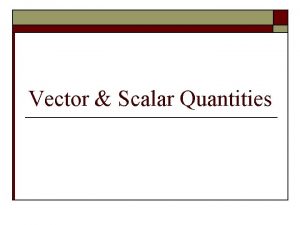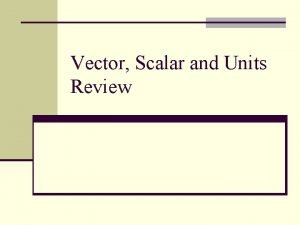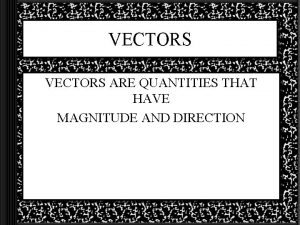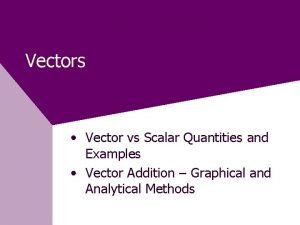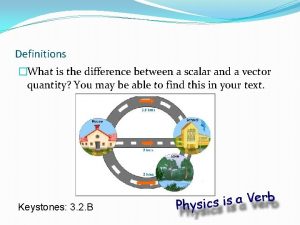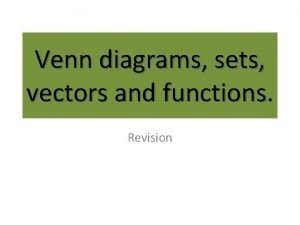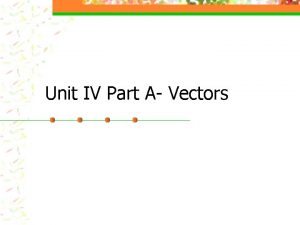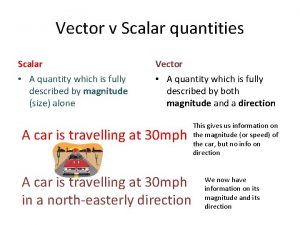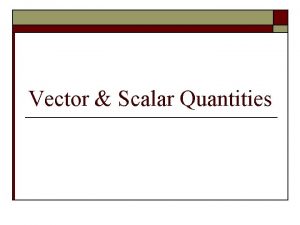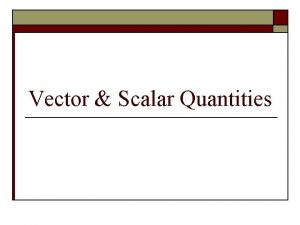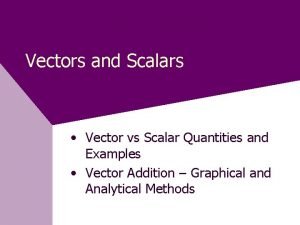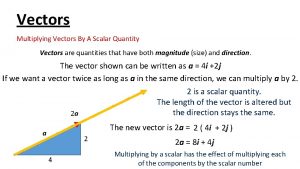Vectors Vector vs Scalar Quantities and Examples Vector






















- Slides: 22

Vectors • Vector vs Scalar Quantities and Examples • Vector Addition – Graphical and Analytical Methods

What is a Scalar Quantity? • A scalar quantity has magnitude (amount, includes a number and unit) only. • Some examples of scalar quantities are: distance (5 m) speed (20 m/s) mass (3 kg) time (4 sec) volume (30 ml)

What is a vector quantity? • A vector quantity requires magnitude and direction to completely describe it. • An arrow or ray is used to represent a vector. The length of the arrow represents the magnitude and the arrow points in the direction of the vector. • Some examples of vectors are: displacement (5 m, North) velocity (20 m/s @ 60º) acceleration (20 m/s 2, South)

Drawing a Vector • Choose an appropriate scale for the vector. Make sure the scale doesn’t make the vector less than 2 cm long. • Using graph paper, mark your origin (starting point). If not on graph paper, make an origin like this: • Measure the angle of the vector from east (or 0° or positive x-axis) using a protractor and mark it. Draw a light line from the origin to that mark. • If the angle is beyond 180°, you must turn your protractor upside down.

Drawing a vector con’t • Starting at the origin, darken the line for the correct length according to the scale and include an arrow tip to indicate the direction. • Example: Draw 40 km @ 150° Scale: 1 cm = 10 cm 4 cm 150°

Distance vs Displacement • Distance – length, “how far”, scalar • Displacement – length and direction, “how far” in a given direction, vector, final position – initial position 3 m, E • Ex: 2 m, N +3 m, E + 2 m, S Total distance = 2 m + 3 m + 2 m = 7 m Displacement = 3 m, east 2 m, N 3 m, E displacement 2 m, S

Vector Addition • When two or more vectors are added, the directions must be considered. • Vectors may be added Graphically or Analytically. • Graphical Vector Addition requires the use of rulers and protractors to make scale drawings of vectors tip-to-tail. (Less accurate) • Analytical Vector Addition is a mathematical method using trigonometric functions (sin, cos, tan) and Pythagorean theorem.

Resultant • The resultant is the sum of the vectors being added. • The resultant vector is drawn from the tail of the first vector (origin or starting point) to the tip of the last vector (end or finish). • The angle for the resultant is measured using a protractor at the origin or starting point. If possible measure from east (0° or positive x-axis) and that is the resultant angle, since angles are assumed to be measured from east counter-clockwise.

Resultant – con’t • If not possible, measure the acute angle from N (90°), W (180°), S (270°), or (360°). • Adjust it by adding directions such as N of W. • Or by adding (or subtracting) the acute angle to (from) 90°, 180°, 270°, or 360° depending on whether the acute angle is before(subtract) or after (add) 90°, 180°, 270°, or 360°. • Ex: The angle below would be 30° S of W or 210° (180° + 30° since the 30° is past 180°).

Graphical Addition of Several Vectors. Given vectors A, B, and C • Draw each of the vectors tip-to-tail to scale. • Draw the resultant from the tail of first vector to tip of last vector (start to finish) B C R R=A+B+C A (direction of R)

Graphical Addition Resultant R=A+B+C Given vectors A, B, &C R A B C (direction of R) • To get the magnitude of the resultant, measure the length of R and multiply by the scale factor. • To get the direction of the resultant, measure the angle from 0° (or E or +x) to the resultant vector. If more than 180°, see the previous resultant slide.

1 D Vector Addition - Analytically • When adding vectors in the same direction, add their magnitudes and the resultant direction is the same. Ex: 5 m, E + 10 m, E = 15 m, E • When adding vectors in the opposite direction, subtract their magnitudes and the resultant is in the same direction as larger magnitude. Ex: 5 m, E + 10 m, W = 5 m, w

1 D Vector Addition - Analytically • To simplify a vector addition of several vectors, add all the vectors going the same way first and then subtract the ones going in the opposite direction. • Ex: 5 m, E + 10 m, W + 3 m, W + 2 m, E (add the easts and add the wests) = 7 m, E + 13 m, W (subtract the opposite directions) =6 m, W

Right Triangle Trigonometry hypotenuse C opposite B A sin = opposite hypotenuse cos = adjacent hypotenuse tan = opposite adjacent And don’t forget: Pythagorean Theorem A 2 + B 2 = C 2

Adding 2 -D vectors that form a right triangle analytically • Sketch (no scale needed) the vectors tip to tail. Draw resultant from start to finish. • Calculate the magnitude of the resultant using the Pythagorean theorem. • Calculate the angle using inverse tangent. R 24 m 18 m

Stating the resulatant angle if it is not in the first quadrant • Note: If the angle is not in the first quadrant measured from east or 0º counter-clockwise, you must adjust it. • Examples (not to scale): 50º 30º Since the angle is measured from 270º and is before 270º, subtract from 270º. Angle = 270º - 50º = 220º Since the angle is measured from 180º and is after the 180º, add to 180º. Angle = 180º + 30º = 210º

Another way to state the resultant angle if not measured ccw from East or 0º Besides 220º, this angle could be stated as 50º West of South. Note: The last direction (S) is the direction the angle is measured from. Besides 210º, this angle could be stated as 30º South of West

Vector Resolution – resolve into x and y components Given: vector A at angle from horizontal. Resolve A into its components. (Ax and Ay) y A Ay x Ax Evaluate the triangle using sin and cos =Ax/A so… Ax = A cos sin = Ay/A so… Ay = A sin Hint: Be sure your calculator is in degrees!

Vector Addition-Analytical To add vectors mathematically: – resolve the vectors to be added into their x- and ycomponents. – Add the x- components together to get the x component of the resultant vector (Rx ) – Add the y- components together to get the y component of the resultant vector (Ry ) – Sketch Rx and Ry tip to tail. Sketch the resultant, R from tail of Rx to tip of Ry (start to finish). – Use the pythagorean theorem and Rx and Ry to find the magnitude of resultant. – Use inverse tangent to find the angle and then adjust to find the direction of the resultant.

Vector Addition-Analytical Ex. First, calculate the x and y components of each vector. Given: Vector A is 90 u, 30 O and vector B is 50 u, 125 O. Example: Find the resultant R = A + B mathematically. By B 55 O Bx A Ay 30 O Ax Ax= 90 cos 30 O = 77. 9 u Ay= 90 sin 30 O = 45 u Bx = 50 cos 55 O = - 28. 7 u By = 50 sin 55 O = 41 u Note: Bx is negative because it is acting along the neg x axis. Using 125 O instead of the reference angle of 55 O will result in a negative value (so don’t need to add the neg).

Vector Addition-Analytical Ex. (continued) Find Rx and Ry: Rx = A x + B x R Ry Rx Ry = A y + B y Rx = 77. 9 - 28. 7 = 49. 2 u Ry = 41 + 45 = 86 u Use: R 2 = Rx 2 + Ry 2 to find magnitude of R. R 2 = (49. 2)2+(86)2 , so… R = 99. 1 u Use: = tan-1 ( Ry / Rx ) to find the angle. = tan-1 ( 86 / 49. 2 ) = 60. 2 O

Stating the final answer • All vectors must be stated with a magnitude and direction. • Angles must be adjusted to be measured from East (or 0° or the + x-axis) counterclockwise or by adding compass directions ( i. e. N of W) • When added graphically, the length of the resultant must be multiplied by the scale factor to find the magnitude.
 Scalar characteristics
Scalar characteristics All scalar and vector quantities
All scalar and vector quantities Vector quantity
Vector quantity A value that only has magnitude
A value that only has magnitude Vector vs scalar quantities
Vector vs scalar quantities Scalar vs vector
Scalar vs vector Relationship between angular and linear quantities
Relationship between angular and linear quantities Properties of a vector
Properties of a vector Units, physical quantities and vectors
Units, physical quantities and vectors Slidetodoc.com
Slidetodoc.com Magnitude of unit vector formula
Magnitude of unit vector formula Scalar product of vectors
Scalar product of vectors 30 examples of vector quantities
30 examples of vector quantities Example of vectors
Example of vectors Physics vectors
Physics vectors Scalar and vector projections
Scalar and vector projections Dot
Dot Find the scalar and vector projections of b onto a
Find the scalar and vector projections of b onto a Scalar and vector quantity difference
Scalar and vector quantity difference Scalar quantity and vector quantity
Scalar quantity and vector quantity Scalar and vector quantization
Scalar and vector quantization Given the venn diagram below, what is the correct notation?
Given the venn diagram below, what is the correct notation? Which of the following is a pair of vector quantities
Which of the following is a pair of vector quantities
